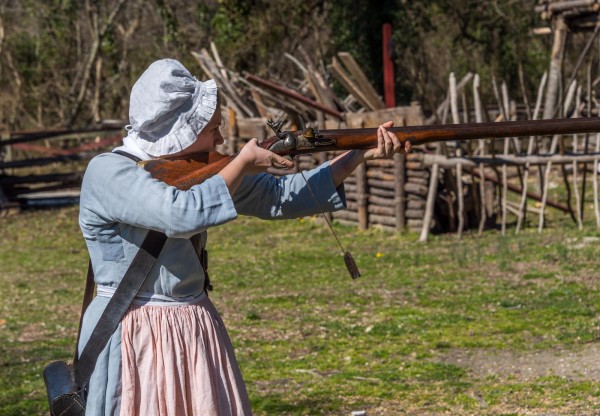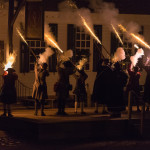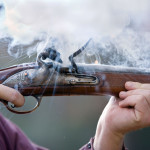
What did recruits in the Continental Army and the Militia have to go through during training? Follow me as I learn drills and how to fire an 18th-century musket.
No, women didn’t really join up when the time came, but now, 240 years later, women across The Colonial Williamsburg Foundation are given the chance to undergo militia training without hiding in secret.
For the past few weeks, I’ve been spending about an hour a day with Seth Herbert (my sergeant) with Military Programs, and some of the amazingly talented folks from our Actor-Interpreter group. We’re all learning how to stand at attention, march, and handle an 18th-century weapon, among other duties. Seth has been a great teacher!
First of all, I’d like to air my grievances about how unfriendly the Continental Army was with left-handed folks like me. There was no such thing as left-handed shooting in the Army, and while I know it’s for a good reason (no one wants a fiery blast in their face), it took some extra time for me to train my brain to reach for certain parts of the musket with my right hand instead of my left. I’ll admit, I got pretty frustrated with myself when I was having to take a few extra seconds swapping hands, and after about six lessons I still have some issues, but… I’m getting better. Thankfully, Seth told me it was common for some soldiers in the 18th century to be on the awkward squad for that very same reason.
Now that I’ve gotten that on my chest, let me walk you through a typical session. We begin by standing at attention and waiting for our sergeant to let us inside to get our scabbard (which holds the bayonet), a cartridge box, and a musket. Once we’ve secured our items, we head back out to stand at attention and await our next orders.
Seth proceeds to walk us through the moves and then it’s our turn. We go through drills such as “Rest,” “Order,” “Shoulder,” and “Poise” (all with “your firelock” following). We work on what Seth calls “soft cheese.” We want all of our movements to be very brisk and tight and not that of soft cheese. He makes it look so easy. If you’ve seen him in our “An Officer’s Message to the People” program, he can be seen recruiting guests on the Duke of Gloucester Street and teaching them to march. He also participates in many Military programs here in the Revolutionary City. Fun fact: Seth also served in the Marines for four years, so he definitely knows what he’s doing!
On our sixth day of training, we got to fire the black powder. That means we got to fire the muskets without ammunition. We learned women did fire weapons in their full outfits in the 18th century so we had a choice to wear a costume if we wanted. I took advantage of the opportunity along with my very good friend Nicole Brown (she recently blogged about our new Women’s History Month programming!). We started by marching down from the Magazine to the Military Encampment.
Once at the Encampment, we went through some drills again and then prepared to fire the black powder. Everyone in my group was ready to shoot and one by one we stepped forward. We primed and loaded our firelocks. We shouldered our firelocks. We made our firelocks ready. We presented our firelocks. We fired.
I was nervous to do this for the first time. It’s silly to think back on it now, but I wanted to make sure I did everything right. I also wasn’t sure how much kickback there would be on the musket. I was surprised to find absolutely none when firing the black powder (I’ll get back to you on what it’s like when firing ammunition!).

This experience has been incredible and I feel so fortunate to be able to participate. To get to do exactly what my ancestors did right here in the Tidewater area 240 years ago is an amazing feeling. It’s something else to be able to connect with your family that way. So the next time you’re watching “On to Yorktown and Victory,” make sure to pay attention to the militia members who are firing their weapons. They went through a great training program to provide that period-authentic interpretation!
Many, many thanks to Wayne Reynolds, Fred Blystone and Dave Doody for taking pictures of our training. And a special thanks to Thomas Derose and Seth Herbert for letting me join in on a regular training session and allowing photographers to be there. You guys are the real MVP(s).



Tell me about it. Being left-eyed, and right handed makes hunting a challenge.
I got to fire the musket for real today at the Musket Range and was shocked I hit the target every single time! Maybe my Militia training helped, but it was strange to see that happen shooting with my right hand.
Does this ever bring back great memories. My husband and I did a very similar program. I got reprimanded for my ‘chicken elbows”. Our sgt. would have none of that! It was great fun but very hard work. We did not get to carry firearms though. That I would have loved. Some students were not taking this seriously and Sarg let them have a barrage of loud words about paying attention. That got them serious in a hurry! all in good fun.
Chicken elbows is very accurate, Jeannine! The ‘soft cheese’ makes me giggle but it’s definitely true. Seth told us there are some 18th-century terms we don’t use now because they are the kind that would make kids laugh and not pay attention.
It’s great that all of the staff are allowed to go through the militia training. Nevertheless, I hope CW doesn’t start having women, dressed as women, participating in militia drills as part of its public programs. I don’t think having women parade down DOG street with muskets in 18th century women’s dress is a good idea. I know women used firearms on more than a few occasions during the colonial period but they were not part of the militia - as the post indicates - and only a mere handful served as Rev War soldiers (disguised as men at that). Let’s not surrender accuracy to political correctness or warm and fuzzy feelings. There was nothing in the excellent post indicating that would occur but I figured it best to make a cautionary comment.
Mick,
This is just for training purposes only! Any women who participate in the programming will be dressed in Militia or Continental Army costumes. Those of us who wore costumes did so so we could protect our own clothing!
Really? Wearing costumes to protect your clothing? Beat up jeans or sweatpants and an old sweatshirt would have been more appropriate for something like that. By the way - I really enjoyed the post and strongly support having non military interpreters participate in the training. All I intended was to make a cautionary note. There are many visitors who don’t know that much about colonial history and are apt to get an inaccurate picture of the past when they see women in colonial outfits parading down DOG street in a military formation.